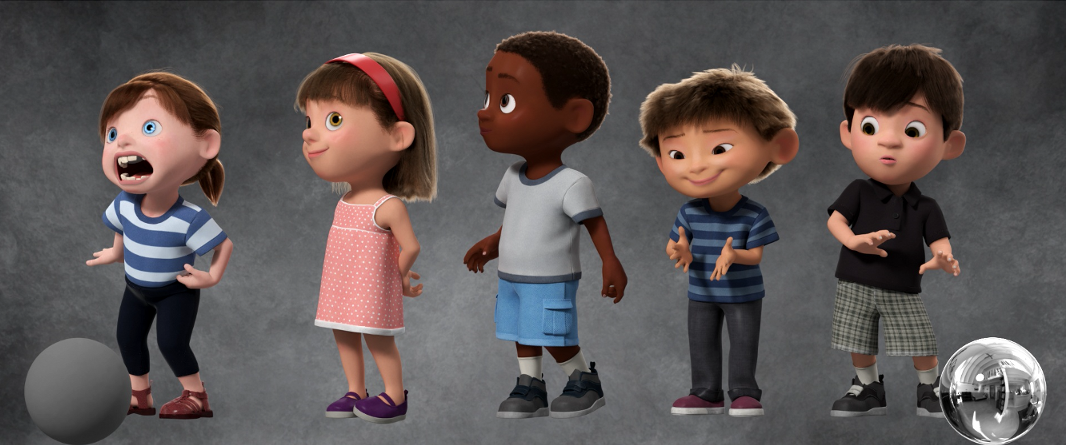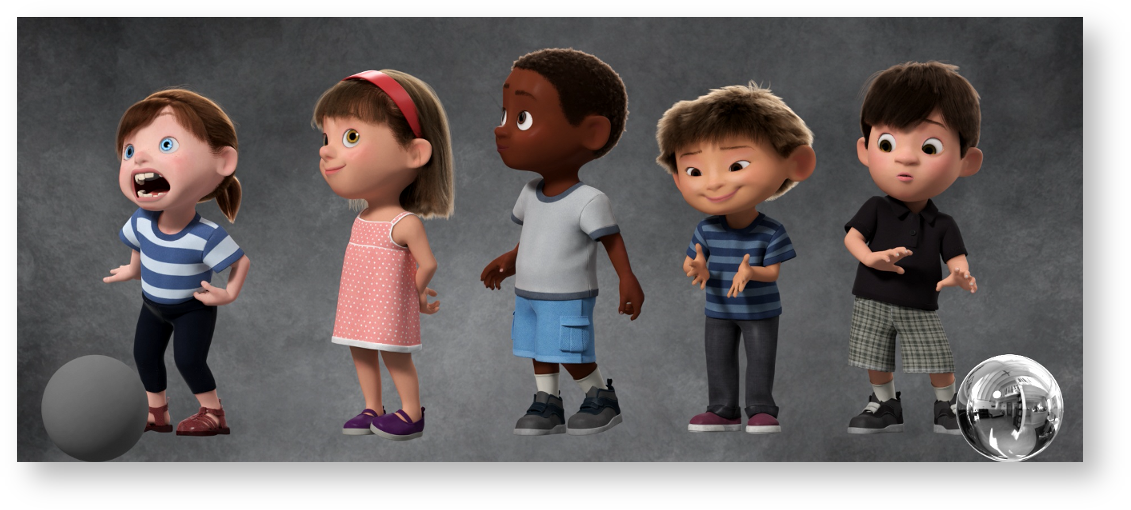...
| Info |
|---|
You can find an easier way to shade and control hair using a pattern included with RenderMan: PxrHairColor |
© Disney/Pixar
PxrMarschner is a material designed to render realistic hair, fur, and fibers.
...
The examples below will illustrate how changing parameters affects the look of the hair.
| Carousel Image Slider | ||||||||
|---|---|---|---|---|---|---|---|---|
|
Diffuse Parameters
There are two choices of diffuse models: Zinke and Kajiya. By default, it is set to Zinke diffuse model which is for bidirectional scattering. See Importance Sampling for Physically-Based Hair Fiber Models.
...
This is the diffuse color of the hair itself. Even for blond hair this is a darker shade than other color parameters for most realistic hair. For the best realism we recommend this be the same color as your Secondary Specular Color and adjust the gain alone. The default is middle grey.
| Carousel Image Slider | ||||
|---|---|---|---|---|
|
...
- Primary Specular: R is for "reflect" where light hits the surface of the hair and reflects. This is the strong primary colorless specular.
- Secondary Specular: TRT is for "transmit", "reflect", and "transmit" where light transmits through the hair surface, then it reflects from inside the hair and exits the front of the hair. This is the secondary colored specular.
- Transmit Specular: TT is for "transmit" and "transmit" where light transmits into the hair surface and then exits through the other side. This is the colored transmission that responds to rim lighting.
...
| Note |
|---|
The Specular Gain controls allow the artist to break energy conservation for artistic purposes. If the values entered add to greater than 1.0 then the hair is not energy conserving. This is only important if you are unsatisfied with the look (it's too "hot") or are interested in starting with physically realistic shading. |
| Info |
|---|
The default gain is now 1.0, previous versions may have been set to 0.33. |
Primary Specular Gain
Gain for the R lobe of Marschner specular. This is like a clearcoat where the specular is fairly sharp and glossy and normally not colored. This specular is a direct reflection which is not tinted by any volume attenuation. Modifications of the R lobe help to make a hair look "wet" as well.
| Carousel Image Slider | ||||||||||
|---|---|---|---|---|---|---|---|---|---|---|
|
...
Gain for the TRT lobe of Marschner specular. This is a rougher and colored specular. This goes through the hair fiber volume twice.
Transmit Specular Gain
Gain for the TT lobe of Marschner specular. This is a transmission-type (refraction) specular with some volume attenuation. It goes through the fiber volume once. High values may increase noise.
...
Gain for glints. This is a multiplier for the effect of Glints and operates like the other gain controls.
| Anchor | ||||
|---|---|---|---|---|
|
...
Because it represents two paths inside the hair fiber, it should be darker and more saturated than the Transmit Specular Color which technically is the square root of the Secondary Specular Color. For more realistic hair this should match with the Diffuse Color.
| Carousel Image Slider | ||||||||||
|---|---|---|---|---|---|---|---|---|---|---|
|
...
Cone angle (theta) for the R lobe in degrees. The broader the angle, the softer and broader the highlight.
| Carousel Image Slider | ||||||||||
|---|---|---|---|---|---|---|---|---|---|---|
|
...
Cone angle (theta) for the TRT lobe in degrees. The broader the angle, the softer and broader the highlight.
| Carousel Image Slider | ||||||||||||||
|---|---|---|---|---|---|---|---|---|---|---|---|---|---|---|
|
...
Cone angle (theta) for the TT lobe in degrees. The broader the angle, the softer and broader the highlight. Note that high gain for this parameter makes for soft and light colored hair but generates quite a bit of noise. This may increase render times at higher angles.
| Carousel Image Slider | ||||||||||||
|---|---|---|---|---|---|---|---|---|---|---|---|---|
|
Specular Offset
Cone offset in degrees, this can be used to shift the specular result along the hair.
| Carousel Image Slider | ||||||||||||
|---|---|---|---|---|---|---|---|---|---|---|---|---|
|
Refractive Index
The refractive index (ior) of the hair. Higher numbers increase the specularity similar to how this would work on opaque surfaces. This can make for an almost metallic looking hair fiber.
| Carousel Image Slider | ||||||||||||
|---|---|---|---|---|---|---|---|---|---|---|---|---|
|
Fresnel Mix
This control is to balance the fresnel energy attenuation along the hair.
| Carousel Image Slider | ||||||||||||
|---|---|---|---|---|---|---|---|---|---|---|---|---|
|
Glint Width
This parameter smooths the Secondary Specular (TRT) and Glints distribution. This value should typically remain between 10 and 25 for realistic hair.
...
| Carousel Image Slider | ||||||||||||
|---|---|---|---|---|---|---|---|---|---|---|---|---|
|
...
Eccentricity
This is the cross-section aspect ratio of the hair and is usually between 0.85 and 1.0 for realistic hair. This is most often used when rendering curly hair. (Note this depends on the hair normals, you should supply user normals through a PrimVar other than specifying N.)
Glow
Glow can be used to create hair fibers that appear to emit light or "glow" in the scene.
...
This value should be either 0 or 1. A value between 0 and 1 will produce unwanted noise!
Eccentricity Direction
This parameter can be used to override the geometric normals for controlling the Eccentricity parameter.
Shadow Color
Specify shadow color. This parameter is useful for faking a shadow color for art direction purposes. Note that this creates "transparent shadows" and will increase render time as more rays are traced between hairs. It may also influence global illumination between the objects.
| Expand | ||
|---|---|---|
| ||
Below are the named and user lobes from PxrMarschnerHair. Named Diffuse Lobe
Named Specular Lobes
User Lobes
|


